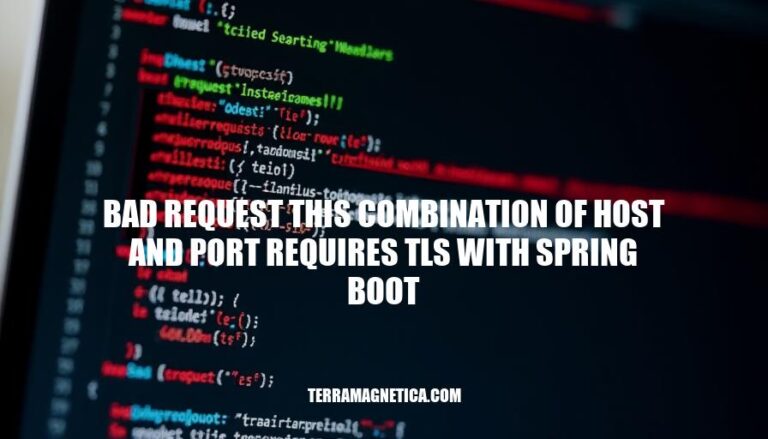


In Spring Boot applications, encountering the error message “Bad Request: This combination of host and port requires TLS” typically indicates a misconfiguration where a secure connection (HTTPS) is required but not properly set up. Addressing this error is crucial as it ensures secure communication between the client and server, protecting sensitive data from potential threats and maintaining the integrity and confidentiality of the application.
The error “Bad Request: This combination of host and port requires TLS” in Spring Boot means that the server expects a secure connection (HTTPS) but received an insecure request (HTTP).
Here are the potential causes for the “Bad Request: This combination of host and port requires TLS” error in Spring Boot:
Incorrect Network Configuration:
Missing TLS Certificates:
Using HTTP Instead of HTTPS:
Incorrect Authentication Configuration:
Outdated or Incompatible Dependencies:
Improper TLS Configuration in Spring Boot:
application.properties or application.yml file, such as wrong keystore or truststore configurations, can cause this error. Verify that the TLS settings are correctly configured.Here’s a step-by-step guide to configure TLS in Spring Boot to resolve the ‘bad request this combination of host and port requires TLS with Spring Boot’ error:
Use the keytool command to generate a key pair and store it in a keystore file.
keytool -genkeypair -alias myalias -keyalg RSA -keysize 2048 -validity 365 -dname "CN=localhost" -keypass changeit -keystore keystore.p12 -storeType PKCS12 -storepass changeit
Add the following properties to your application.properties file to enable TLS:
# Enable HTTPS
server.ssl.enabled=true
# Keystore type
server.ssl.key-store-type=PKCS12
# Keystore location
server.ssl.key-store=classpath:keystore.p12
# Keystore password
server.ssl.key-store-password=changeit
# SSL protocol
server.ssl.protocol=TLS
# Enabled SSL protocols
server.ssl.enabled-protocols=TLSv1.2
Ensure your Spring Boot application is configured to use the correct port for HTTPS (default is 8443).
server.port=8443
Start your Spring Boot application and access it via HTTPS.
mvn spring-boot:run
Access your application using https://localhost:8443 to ensure TLS is correctly configured.
This setup should resolve the ‘bad request this combination of host and port requires TLS with Spring Boot’ error. If you encounter any issues, double-check the keystore path and passwords.
To validate the TLS configuration in Spring Boot and resolve the “Bad Request: This combination of host and port requires TLS” error, follow these steps:
Generate a Key Pair:
keytool -genkeypair -alias myalias -keyalg RSA -keysize 2048 -validity 365 -dname "CN=localhost" -keypass changeit -keystore keystore.p12 -storeType PKCS12 -storepass changeit
Configure application.properties:
server.ssl.enabled=true
server.ssl.key-store=classpath:keystore.p12
server.ssl.key-store-password=changeit
server.ssl.key-store-type=PKCS12
server.ssl.key-alias=myalias
server.ssl.protocol=TLS
server.ssl.enabled-protocols=TLSv1.2
Run the Application:
Ensure the application starts without errors.
Test with curl:
curl -v --cacert keystore.p12 https://localhost:8443
Use Browser:
Access https://localhost:8443 in a browser and check for secure connection indicators.
openssl s_client -connect localhost:8443 -CAfile keystore.p12
By following these steps, you can validate your TLS configuration and resolve the error.
Incorrect Configuration:
application.properties or application.yml files.server.ssl.enabled=true, correct server.ssl.key-store path, and valid server.ssl.key-store-password.Certificate Issues:
keytool to manage certificates.Protocol Mismatch:
https:// and configure Spring Boot to enforce HTTPS.Firewall/Proxy Interference:
Outdated Dependencies:
Use Strong Encryption:
Automate Certificate Management:
Regular Security Audits:
Comprehensive Testing:
Documentation and Monitoring:
By addressing these pitfalls and following best practices, you can effectively resolve and prevent the ‘Bad Request: This Combination of Host and Port Requires TLS’ error in your Spring Boot applications.
To resolve the ‘Bad Request: This Combination of Host and Port Requires TLS’ error in Spring Boot, ensure that your application is properly configured to use HTTPS. This involves setting up a keystore and truststore, configuring the SSL/TLS settings in your application.properties or application.yml file, and verifying the certificates.
Common pitfalls include incorrect configuration, certificate issues, protocol mismatch, firewall/proxy interference, and outdated dependencies. To avoid these issues, follow best practices such as using strong encryption, automating certificate management, conducting regular security audits, implementing comprehensive testing, and maintaining thorough documentation and monitoring.
Proper TLS configuration is crucial for secure communication between clients and servers in Spring Boot applications.